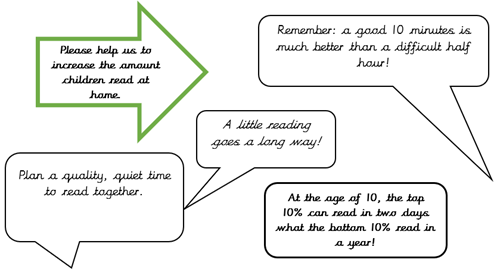
SUPPORTING YOUR CHILD WITH READING
Taking an active interest in your child’s learning is one of the best ways you can help your child to do better in school. Learning is not just about what happens in school. Children are learning all the time through what they see, hear and do.
We have been trying to encourage all of the children to read at home as often as possible and are delighted to say this is having a huge impact on the progress they are making.
During the parent workshops and the ‘read along’ mornings we have been asked for any tips to support parents so I do hope you find this useful.
In school, children are taught a range of strategies they can use to help them work out unknown words.
You asked for support about what you might write in their Reading Records… See below…
|
Strategy |
Comments you could make in Reading Diary |
|
Phonics! If they can sound the word out using the phonics they know then encourage this as the first strategy.
|
Sounded out to read ……..word Used the first sound of the word to read…. Sounded out (add grapheme e.g. ea sh ng Sounded out these words using phonics…………. Blended sounds together to read the words |
Use the picture as a clue (this is not cheating!)
|
Looked at the picture to read an unfamiliar word. Talked about the picture and related it to a sentence. Used the beginning sound to recognise the picture. |
Use picture clues along with the initial letter in the word.
|
Could sound out the beginning sounds of the words. Using the picture and the beginning sound could read the word…. |
|
Predict what the word could be from the sentence it is in.
|
Read the rest of the sentence and could then read an unfamiliar word correctly. Guessed a few words that would have made sense of the sentence. Read a sentence back to make sure it made sense. Self corrected him/herself when they read the sentence/word. |
|
As reading skills develop |
|
|
Reading from left to right and matches each spoken word to a written one
|
Read a text out loud independently. Followed the text without missing a line. Could read frequent ‘tricky’ words. Could point out words and read them that he/she had found tricky . |
|
Recognise errors Re-read to correct and re-reading to check
|
Realised a sentence didn’t make sense. Read a word again that didn’t make sense by sounding out. Repeated a sentence to check it made sense. |
|
Make meaningful but not always accurate guesses |
Guessed the end of a sentence. Could predict what might happen next. |
|
Read with expression
|
Used inverted commas to add expression to the character’s speaking. Shouted or whispered in line with the speech. Was so interesting to listen to as added expression. It was like listening to the radio, lovely expression. |
|
As children progress further they: |
|
|
Use punctuation
|
Used the punctuation to add expression Paused at full stops Used the commas to pause. |
|
Follow print with their eyes
|
Did not need to use his/her finger to follow the words/sentence. Turned the page at the right place when I was reading to them. |
|
Search for information in the print
|
Could answer questions about the text Pointed to evidence in the text when I asked questions. |
|
Read more fluently |
Has made progress with fluency Confident, fluent reading The reading flowed and didn’t sound like a ‘robot.’ |
Important points to remember
Alternate the strategies you suggest rather than giving the same strategy prompt e.g. sound it
Book Introduction: Spend time introducing the book. What do you think this might be about? Why do you think that?
Strategy Check: Ask your child “What can we do if we get stuck on a word?” Listing the strategies refreshes your child’s memory and gives them the confidence to tackle a new word.
Independent reading: During this time try to remind your child of strategies rather than giving unknown words.
Should you have any suggestions to improve reading in school or need any support, please do not hesitate to contact me.
Jo Clarke Deputy Head and Reading Lead
Always happy to help.